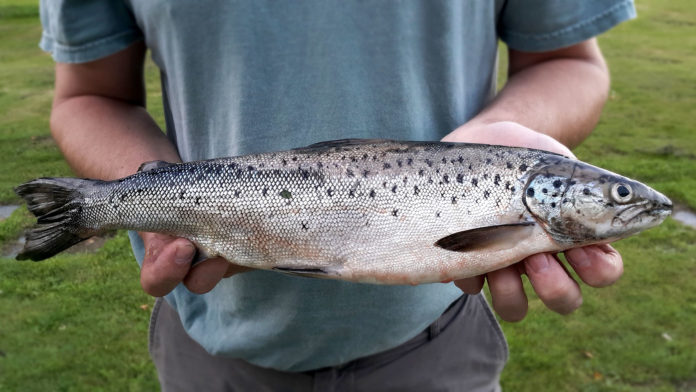A net pen containing 305,000 Atlantic salmon failed on Saturday, releasing an as-yet-unknown number of farmed fish into Pacific waters just east of Victoria. The initial estimates peg the number of escaped fish in the thousands, and experts are split on a broad number of questions on what this means for native wild species.
The number of escaped fish is the highest in a decade, with other smaller incidents numbering in the dozens.
The salmon farm is run by Canada-based Cooke Aquaculture in Washington State near Cypress Island.
The company cites “exceptionally high tides and currents coinciding with this week’s solar eclipse” as the reason for the breach. The tide-gauge measurements taken by the National Oceanic and Atmospheric Administration, however, were actually lower than what was forecast, and also lower than other months in 2017. Company crews on the ground say that although the tide tables were not unusual, the conditions they observed were unprecedented.
What does this mean for the Pacific ecosystem?
Regardless of the cause, the impact the release may have on wild fish ranges anywhere from no big deal to total ecological disaster.
The incident’s proximity to Canada means that our fish are likely to be affected, too. While the Department of Fisheries and Oceans (DFO) believes there is low likelihood for the escaped salmon to establish a stable population, the situation is being closely monitored on both sides of the border.
For historical context, the DFO has actually tried to establish Atlantic salmon colonies in Pacific waters before. In the early 1900s, they intentionally released hundreds of thousands of fry (young salmon) in hopes of creating a sustainable stock for sport fishing. While this was not successful, this release is different.
Ecologist John Volpe, professor of environmental studies at the University of Victoria, says that the potential for breeding is higher because these are more physically fit adult fish. Volpe’s previous work has also shown that escaped Atlantic salmon do breed, although the success rate and potential impact are not well understood.
While breeding is possible, farmed fish will need to compete against more aggressive wild fish for food and resources. But the establishment of a stable colony could be devastating for wild Pacific salmon.
Even if they are ill-equipped for life in the open ocean, farmed fish can also bring with them many parasites and diseases. If an infection spreads to the many juvenile wild fish in the area, this could also be a disaster for wild salmon that are struggling with accelerating urbanization and climate change.
To reduce the potential damage the escaped Atlantic salmon might cause to the Pacific ecosystem, Washington State’s Department of Fish and Wildlife is encouraging locals with fishing licenses to catch as many of the Atlantic salmon as they can. Critics worry about the potential for misidentification, which could endanger other local fish.
All of this raises concerns over standards for fish farms, in particular because Cooke Aquaculture is in the process of proposing an expansion in the nearby Strait of San Juan de Fuca.
The Cypress Island net pen was a rigid steel structure, compared to the newer and more flexible types of net pens that can better withstand rough currents. Volpe goes one step further and proposes land farms as an alternative that could be more easily contained than open net pens.
It will take some time to stabilize the farm and get a final assessment on the number of released fish, but better containment standards and alert systems could help prevent future incidents like this one.








































